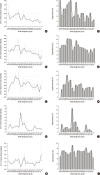Chronological Trends in Clinical and Urinary Metabolic Features over 20 Years in Korean Urolithiasis Patients
- PMID: 28776346
- PMCID: PMC5546970
- DOI: 10.3346/jkms.2017.32.9.1496
Chronological Trends in Clinical and Urinary Metabolic Features over 20 Years in Korean Urolithiasis Patients
Abstract
Urolithiasis is common and is becoming more prevalent worldwide. This study assessed the chronological trends in clinical and urinary metabolic features over 20 years in Korean urolithiasis patients. We performed a retrospective analysis of 4,076 patients treated at our clinic from 1996 to 2015. Urinary metabolic data and stone analysis data were available for 1,421 and 723 patients (34.9% and 17.7%), respectively. Patients were categorized into 4 groups according to the date of initial diagnosis: group 1 (1996-2000, n = 897), group 2 (2001-2005, n = 1,018), group 3 (2006-2010, n = 1,043), and group 4 (2011-2015, n = 1,118). Incidental detection of uric acid renal stones has become more prevalent in the past 10 years, accompanied by an increase in body mass index and age at diagnosis. Similarly, the prevalence of diabetes mellitus and of hypertension increased from one group to the next throughout the study period. Levels of 24-hour urinary excretion of sodium, calcium, uric acid, and oxalate have decreased significantly over the study period. The incidence of urinary metabolic abnormalities also showed an identical tendency. The proportion of stones composed of uric acid increased over the study period. In conclusion, incidental detection of uric acid renal stones has become more prevalent in Korea in the past 20 years. Urinary excretion of lithogenic constituents and the incidence of urinary metabolic abnormalities have decreased significantly over this period.
Keywords: Risk Factor; Stone Analysis; Uric Acid; Urolithiasis.
© 2017 The Korean Academy of Medical Sciences.
Conflict of interest statement
The authors have no potential conflicts of interest to disclose.
Figures

Similar articles
-
Correlation of metabolic syndrome with urinary stone composition.Int J Urol. 2013 Feb;20(2):208-13. doi: 10.1111/j.1442-2042.2012.03131.x. Epub 2012 Sep 30. Int J Urol. 2013. PMID: 23020870
-
Role of overweight and obesity on the urinary excretion of promoters and inhibitors of stone formation in stone formers.Urol Res. 2008 Dec;36(6):303-7. doi: 10.1007/s00240-008-0161-5. Epub 2008 Nov 5. Urol Res. 2008. PMID: 18985334
-
Obesity and urolithiasis: evidence of regional influences.Urolithiasis. 2017 Jun;45(3):271-278. doi: 10.1007/s00240-016-0908-3. Epub 2016 Aug 3. Urolithiasis. 2017. PMID: 27488444
-
Dietary treatment of urinary risk factors for renal stone formation. A review of CLU Working Group.Arch Ital Urol Androl. 2015 Jul 7;87(2):105-20. doi: 10.4081/aiua.2015.2.105. Arch Ital Urol Androl. 2015. PMID: 26150027 Review.
-
[Hyperuricosuria and urolithiasis].Nihon Rinsho. 1996 Dec;54(12):3273-6. Nihon Rinsho. 1996. PMID: 8976104 Review. Japanese.
Cited by
-
Twenty-four-hour urine osmolality as a representative index of adequate hydration and a predictor of recurrence in patients with urolithiasis.Int Urol Nephrol. 2019 Jul;51(7):1129-1135. doi: 10.1007/s11255-019-02108-2. Epub 2019 May 14. Int Urol Nephrol. 2019. PMID: 31089946
-
Study on the prevalence and incidence of urolithiasis in Korea over the last 10 years: An analysis of National Health Insurance Data.Investig Clin Urol. 2018 Nov;59(6):383-391. doi: 10.4111/icu.2018.59.6.383. Epub 2018 Oct 23. Investig Clin Urol. 2018. PMID: 30402571 Free PMC article.
References
-
- Skolarikos A, Straub M, Knoll T, Sarica K, Seitz C, Petřík A, Türk C. Metabolic evaluation and recurrence prevention for urinary stone patients: EAU guidelines. Eur Urol. 2015;67:750–763. - PubMed
-
- Ramello A, Vitale C, Marangella M. Epidemiology of nephrolithiasis. J Nephrol. 2000;13(Suppl 3):S45–S50. - PubMed
-
- Bae SR, Seong JM, Kim LY, Paick SH, Kim HG, Lho YS, Park HK. The epidemiology of reno-ureteral stone disease in Koreans: a nationwide population-based study. Urolithiasis. 2014;42:109–114. - PubMed
-
- Yasui T, Iguchi M, Suzuki S, Kohri K. Prevalence and epidemiological characteristics of urolithiasis in Japan: national trends between 1965 and 2005. Urology. 2008;71:209–213. - PubMed
-
- Huang WY, Chen YF, Carter S, Chang HC, Lan CF, Huang KH. Epidemiology of upper urinary tract stone disease in a Taiwanese population: a nationwide, population based study. J Urol. 2013;189:2158–2163. - PubMed
MeSH terms
Substances
LinkOut - more resources
Full Text Sources
Other Literature Sources
Miscellaneous

